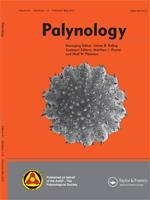Because the Gulf Coast Lower Cretaceous is dated by ammonites, it has great potential as a reference section for correlating continental sequences such as the Potomac Group and dating events in the rise of angiosperms. Middle Albian terrestrial palynofloras from Oklahoma have been described in detail, but the early Albian interval, represented in the Glen Rose Formation of Texas, is less well known. Samples from two localities on the Paluxy River, which correlate with horizons containing late early Albian ammonites, are dominated by Classopollis and Exesipollenites, but angiosperm pollen is the next most common terrestrial element, and there are several index spore species for Zone II in the Potomac Group. Among the angiosperms, reticulate monosulcates are most common and diverse, but there are also several tricolpate species. Stratigraphically important angiosperms include the Clavatipollenites rotundus group and reticulate tricolpates, which appear in the upper part of Potomac Zone I and the dated earliest Albian of England and Portugal. However, there are also tricolpates with striate-reticulate sculpture, a pollen type that is not known from upper Zone I but appears in the late early Albian of Portugal. This assemblage contrasts with floras from Potomac Zone II and the middle Albian (lower Fredericksburg Group) of Oklahoma, where tricolpates overtook monosulcate angiosperms in species diversity. These results confirm arguments based on the Portuguese section that there is a significant hiatus between Potomac Zones I and II, and that this gap is at least partly late early Albian. The dominance of Classopollis and Exesipollenites and the occurrence of isolated Northern Gondwanan elements (Sergipea, Tucanopollis) suggest that Texas lay in a transition zone between Southern Laurasia and the hotter and drier Northern Gondwana province, but regional studies are needed to disentangle geographic and climatic factors from effects of the lagoonal local environment.
How to translate text using browser tools
1 October 2018
Early Cretaceous (Albian) Spores and Pollen from the Glen Rose Formation of Texas and their Significance for Correlation of the Potomac Group
Sinem Tanrikulu,
James A. Doyle,
Irina Delusina
ACCESS THE FULL ARTICLE
It is not available for individual sale.
This article is only available to subscribers.
It is not available for individual sale.
It is not available for individual sale.

Palynology
Vol. 42 • No. 4
November 2018
Vol. 42 • No. 4
November 2018
Albian
angiosperms
Cretaceous
palynology
Potomac
stratigraphy
Texas




